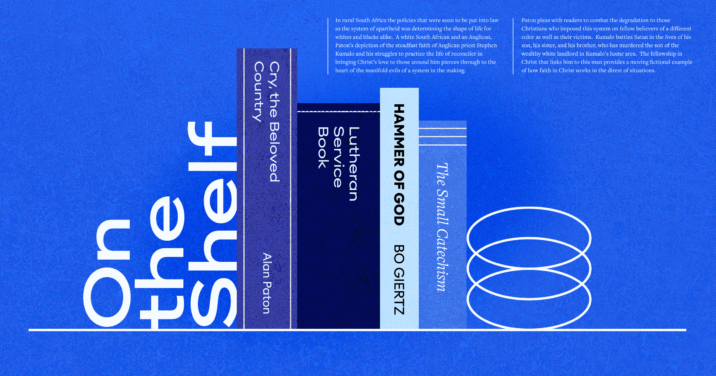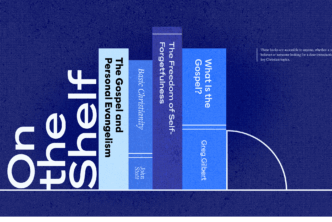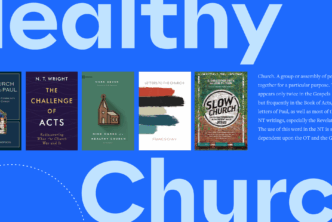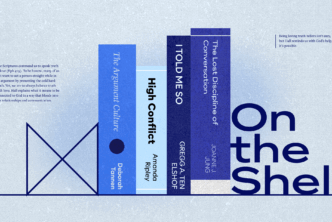Editor’s note: The resources recommended in our On the Shelf series are the opinions of the featured individuals, not those of Logos. We are publishing a breadth of voices to reflect varying perspectives within the church.
Robert Kolb, professor of systematic theology emeritus at Concordia Seminary, Saint Louis, is co-editor with Timothy J. Wengert of the translation of The Book of Concord (Fortress Press, 2000), co-editor with Irene Dingel and L’ubomír Batka of The Oxford Handbook of Martin Luther’s Theology (Oxford, 2014) , and author of Luther’s Treatise On Christian Freedom and Its Legacy (Fortress Academic, 2019), Martin Luther and the Enduring Word of God (Baker Academic, 2016), and numerous other works on Luther and Lutheran theology, as well as, with Carl Trueman, Between Wittenberg and Geneva: Lutheran and Reformed Theology in Conversation (Baker Academic, 2019).

1. Cry, the Beloved Country, by Alan Paton
In rural South Africa, the policies that were soon-to-be put into law as the system of apartheid was determining the shape of life for whites and blacks alike. A white South African and an Anglican, Paton’s depiction of the steadfast faith of Anglican priest Stephen Kumalo and his struggles to practice the life of reconciler in bringing Christ’s love to those around him pierces through to the heart of the manifold evils of a system in the making. Paton pleads with readers to combat the degradation to those Christians who imposed this system on fellow believers of a different color as well as their victims. Kumalo battles Satan in the lives of his son, his sister, and his brother, who has murdered the son of the wealthy white landlord in Kumalo’s home area. The fellowship in Christ that links him to this man provides a moving fictional example of how faith in Christ works in the direst of situations.
2. Hammer of God, by Bo Giertz
Giertz, bishop of Göteborg, sketches the challenges of pastors young and old in nine short stories, set in the same parish in western Sweden in three different eras, the early nineteenth century with pastors educated in an enlightened atmosphere that failed to give them the depth of what trusting in Christ means in deep spiritual crisis; the last quarter of the nineteenth century, with challenges of a legalistic pietism that had combatted alcoholism and other evils with a law apart from the gospel of the forgiveness of sins; and the 1930s, with confrontations from new forms of legalism in, for instance, moral rearmament, and by an antinomianism that fails to understand the transforming power of the mercy of Christ for sinners. Giertz often places profound testimonies of faith in Christ in the mouths of lay people, who show the way to the heart of Scripture to their pastors. His models for pastoral engagement and care benefit every reader by placing each of them into the minds and experiences of the often bumbling servants of God and of the common folk who sense the love of God in Christ Jesus in the midst of suffering the rough and tumble of daily life.
3. Lutheran Service Book, by the Lutheran Church Missouri Synod
(Or any of the innumerable hymnals that bring the sung heritage of the church to the individual reader–singer.) The vademecum of believers throughout Christian history, the hymns of the church provide comfort, relaxation, devotional raw material, and lines to memorize as their melodies fix their content in our minds. The grand variety of collections of hymns serve believers of all traditions and denominations, and the liturgies and prayers that most hymnals also provide have fixed the message of Christ, died yet risen, for his people into our minds through their repetition in worship and in private devotions. For moments of reflection, desperation, or overbrimming joy, the reader’s favorite songbook will refresh, revive, encourage, and empower.
4. Luther’s Small and Large Catechism with Select Commentary
The textbook of my childhood and adult faith as found in Luther’s Small Catechism rang in my ears before I could read. My parents used the textbook of their childhood faith to raise me and my brother in the fear and admonition of the Lord. Its simple phrases capture the heart of the biblical message for me and give me expressions of the faith taught by the prophets, evangelists, and apostles that convey clearly what God Father, Son, and Holy Spirit do for me and for others with whom I am conversing. The first commentary on it, Luther’s Large Catechism, provides rich insights into our faith in Christ and the heart of what the biblical writers have to teach us in forms that speak easily into the twenty-first century world(s).
5. Luther’s Commentary on Galatians
Luther hammered out his freshly formulated understanding of the righteousness of the believer in Christ as a passive righteousness accounted to those whom the Holy Spirit has brought to faith and an active righteousness that flows from this passively received gift of God in 1519, as seen in his revision of his lectures on Galatians from 1516 to 1517, and in his On Christian Freedom of 1520. A decade later, in 1531, he lectured on Galatians again; students edited these lectures for publication in 1535. This is the resulting work, representing Luther’s thought in its maturity. Luther meets Paul on the battleground of questions regarding the relationship of faith in Christ to the new obedience that flows from faith. Together, they oppose those who believe that the test of true faith is the human performance it produces. Instead, they rely on trust that God’s promise of new life through the forgiveness of sins won by Christ in dying and rising for his people. Only this external approach of the Holy Spirit in his Word in oral, written, and sacramental forms can assure the faithful that God’s favor has been given unconditionally to them.
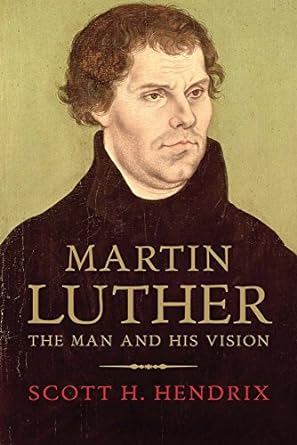
6. Martin Luther: Visionary Reformer, by Scott H. Hendrix
Historians are part gossips, part detectives, and Hendrix satisfies both these urges of mine as he meticulously explores the sources with careful attention to historical context and to the theological dimensions of Luther’s life. Hendrix’s portrayal captures the robust personality of the Wittenberg professor and sketches the contours and contents of his thought with sensitivity to their sixteenth-century significance and their applicability in the twenty-first century. No biography is the story of a single person, and Hendrix weaves Luther’s life and teaching into his interaction with others such as his family (parents, wife Katherine, six children), his Wittenberg colleagues (especially Philip Melanchthon), and his many foes and critics (Roman Catholics such as Johann Eck, Reformed such as Ulrich Zwingli, or former colleagues or students, such as Andreas Bodenstein von Karlstadt or Johann Agricola). This lively introduction to Luther’s person and mind engages readers with the man as best can be done over a five-century span.

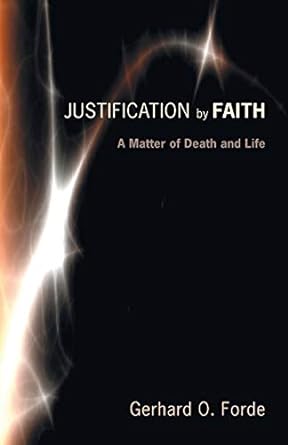
7. Justification by Faith: A Matter of Death and Life, by Gerhard O. Forde
Forde’s exposition of the doctrine of justification centers on the presupposition that God’s promise of new life through the benefits of Christ’s death and resurrection is bestowed through his forensic (i.e., linguistic) pronouncement of reconciliation and liberation that trusting in this promises grasps. Forde explores the biblical basis of this understanding that God effects a new creation by putting sinners to death as those alienated from their Creator and bringing them to new life as those raised to a new identity as children of God. This volume has shaped my preaching and teaching for forty years, for it clearly enunciates the good news that God embraces sinners as his own and transforms them into his children, faithful to their faithful Father. This Word of Christ transforms us by a new creative word of absolution that kills and makes alive, leading Forde to conclude that “the more forensic a doctrine of justification is, the more effective it is.” Those who truly trust that God has forgiven them and brought them out of sin to righteousness in his sight want to and strive to demonstrate this righteousness in their deeds of praise and thanks, of service and obedience.
8. Theology Is for Proclamation, by Gerhard O. Forde
A professor of systematic theology himself, Forde knew the necessity and value of the dogmatic tradition and every Christian’s ability to formulate the biblical message in terms that convey the faith to other believers and to those outside the faith. Therefore, he validates the role of explaining what we believe but only as preparation for proclaiming it, giving witness to Christ as Lord and Savior. The understanding that human speech can be performative, as understood by Austin and Searle, led Forde to build on Martin Luther’s perception that in Scripture God uses human language in the tongues and pens of his prophets and apostles as re-creative speech. God addresses sinners in the form of the promise of new life in Christ. Forde aids readers in knowing how to deliver the benefits of Christ’s death and resurrection to others.
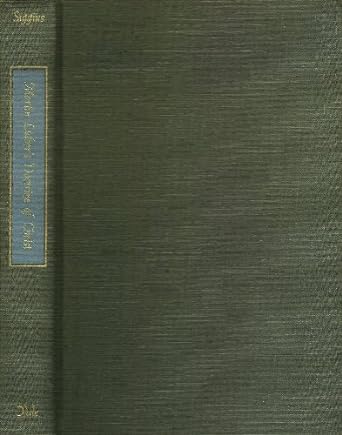
9. Martin Luther’s Doctrine of Christ, by Ian D. Kingston Siggins
Jesus Christ forms the foundation and heart of Luther’s understanding of biblical teaching and of the Christian life. Siggins’s overview and application of how Luther cultivated trust in Jesus Christ as true God and true human being, along with his liberating winning of forgiveness, life, and salvation for those who believe, provides historical information that is easily turned to practical application in the preaching and teaching of God’s people in our day. Siggins’s analyses of the way in which Luther used biblical descriptions of Jesus Christ and what he has done for sinners, as well as the Reformer’s imaginative use of metaphors to convey the gospel, give readers food for thought and material for their own formulation of their faith.
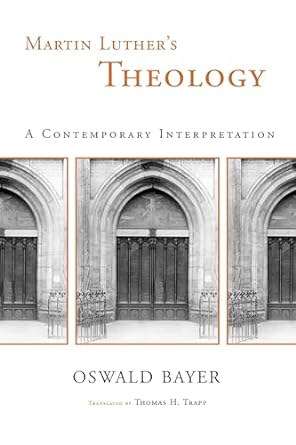
10. Martin Luther’s Theology: A Contemporary Interpretation, by Oswald Bayer
Amidst the bevy of studies on Luther’s theology on my bookshelves, Bayer’s has been the most helpful, although Reinhard Schwarz’s Martin Luther, Lehrer der christlichen Religion (first published 2016) in German corresponds most closely to my historical mind. Bayer’s book arose out of lectures for students in Tübingen who were not studying theology. His presentation of the Reformer’s thought presumes that every human being is a practicing theologian, that is, thinks very much about the object of his or her ultimate trust and is shaped by that conversation with self and others. The topic of theology, according to Bayer (and Luther) is “the sinful human being and the justifying God.” Reading Scripture within the framework of Luther’s program of prayer (meditation) in the midst of struggling with spiritual attack, a person hears the promise of forgiveness that liberates for living a life of faithfulness to God in the midst of the communion of his church. Believers, as creatures created in the image of God and rescued from sin through Christ, answer God’s call to serve as agents of his providence within the created order, in the church, the household, with its activities in family life and economic life, as the Holy Spirit reassures them of God’s love through his active, effective Word in oral, written, and sacramental forms.
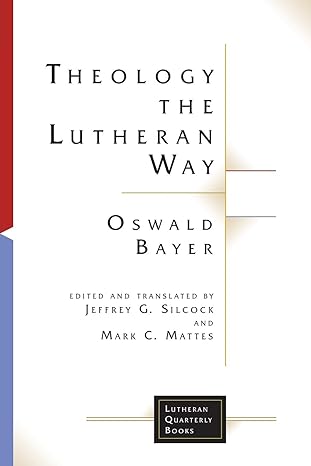
11. Theology the Lutheran Way, by Oswald Bayer
Translated from parts of Bayer’s 1994 Theologie, this volume places the method and practice of the theology of Martin Luther in the context of historical developments in the presuppositions and philosophical framework of nineteenth century. Bayer challenges the dominance of these forms in the practice of contemporary theology. Bayer demonstrates how Luther provided a better approach to this practice for our time. With the aid of Luther’s own formulation for reading the Scriptures in the framework of “oratio, meditatio, and tentatio” and using the Reformer’s conviction that God speaks his performative, re-creative word of promise to us from the biblical page, Bayer proposes how the academic discipline of theology functions within the larger context of learned discussion today. His focus on God’s promise and the trust it creates offers theologians the insights of the past for effective proclamation of new life in Christ today.
12. Living by Faith: Justification and Sanctification, by Oswald Bayer
Bayer demonstrates how biblical theology centers on the justification of the ungodly through God’s declaration of absolution that renders the sinners righteous through God’s act of new creation on the basis of the work of Christ. Arguing that contemporary people continually engage in the justification of their own person, Bayer draws implications from God’s justifying promise of absolution through the death and resurrection of Jesus permeates all Christian thinking. He deals with theodicy, carefully following the confrontation of Job with his claims of righteousness and the sovereign Creator of the universe. The volume rehearses Bazer’s investigation of the biblical understanding of sin as broken relationship and of Scripture’s tracing the interaction of the Creator with his people, at the same time righteous in God’s sight and struggling with sin. He concludes that people who trust that the Holy Spirit’s word of absolution makes them truly righteous naturally act righteously in their praise of God and their care and love for others. Thus, sanctification is not a separate supplement to justification but the instinctive outflow of the trust that defines one as God’s new creature.
13. Creation and Fall, by Dietrich Bonhoeffer
Bonhoeffer’s lectures on Genesis 1–3 from 1932 to 1933 ground the Christian faith in the speach of God, the Creator of all. His creative Word determined the nature of the human creature whom he fashioned in his own image. This Word fixed the boundaries of reality and continues to sustain what he made. Bonhoeffer explores the nature of the servant–dominion God gave these human creatures. He depicts vividly how their doubting God’s Word fostered the need and desire “to be like God” and how their fleeing God provoked his pursuit of them in his desire to remain in conversation and community with them. God cursed Adam and Eve for their sin but extended to them the promise of a Savior who would triumph over the serpent. My edition of the book adds Bonhoeffer’s 1937 meditation on temptation, Christ’s and ours, as an aid for readers in the daily combat with Satan through the power of God’s good news in Christ.
14. Life Together, by Dietrich Bonhoeffer
This reflection of life together in the underground seminary of the German Confessing Church in which Bonhoeffer taught in the 1930s depicts in detail the way in which believers live together within the framework of Christ’s promise of new life as it unfolds in the Christian community. Bonhoeffer presumed that God creates the common bonds bringing brothers and sisters together through faith in Christ. He explores the structures of the day that guide meditation and activities of love, care, and service that mark life together as a working and worshipping community. His assessment of solitude and silence in the Christian life takes seriously the blessings and temptations of being alone with one’s own thoughts. A review of service or ministry to one another in the community includes holding one’s tongue, meekness, listening, helping, bearing burdens for one another, proclaiming God’s Word, and exercising authority in godly fashion. Our life together climaxes in confession of sins and absolution and in the Communion at the Lord’s table.
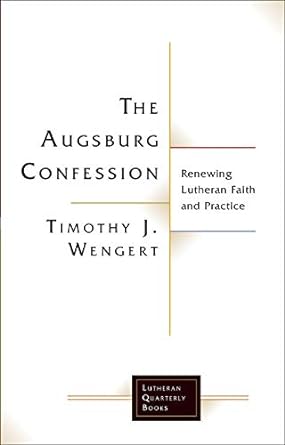
15. The Augsburg Confession: Renewing Lutheran Faith and Practice, by Timothy J. Wengert
Following the model of his A Formula for Parish Practice (Fortress, 2006), which put the articles of the Formula of Concord of 1577 in historical context and in the context of pastoral application and use today, The Augsburg Confession provides anecdotal demonstrations of how the theology of the sixteenth-century Reformers can come to life in contemporary North American cultures. Wengert’s own experience and his years of research exploring the text of the Lutheran confessions give models to pastors of all traditions that aid their thinking about shepherding the flock to which God has sent them.
16. The Complete Sherlock Holmes, by Sir Arthur Conan Doyle
Arthur Conan Doyle and I think of God in quite different ways, but his insight into the subtle powers of the evil mind and the native gift from God of our ability to observe if we just pay attention bring delightful entertainment with which to close a day. Holmes and Watson portray the imagination of those bent on self-aggrandizement at the expense of others and just plain evil; they also model the potential for observation that lies within us all. Modern detective stories display more action and literary sophistication, but accompanying Holmes and Watson on their pursuit of the villain(s) relaxes and amuses along with its lessons on humanity in a sinful world.
Don’t miss these other book recommendations
- Hot Takes on Top Commentary Sets in Logos
- 10 Anglican Books You Should Know
- 42 Best-Selling Books by & for Pentecostals
- 40 Best-Selling Books for Baptists

